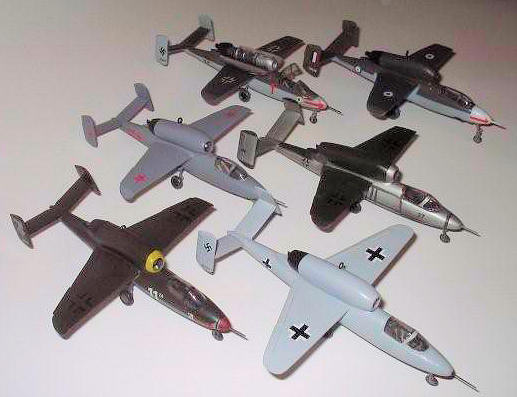
1/72
Heinkel HE-162A
| KIT #: |
(1)
Lindberg #432, (1965);
(2)
Frog #F401 (Late
Sixties?);
(3) DML # 5001
(1990); and
(4)
Hobby Boss #80239 (2008) |
| PRICE: | All but the Dragon kit can be found for under $10 |
| DECALS: | See Review |
| REVIEWER: | Brian Baker |
| NOTES: |
Four marginally available kits of this aircraft are compared and
contrasted as built OOB. |

| HISTORY |
The
Heinkel HE-162A, known variously as the
“Spatz” (Sparrow),
“Salamander”, and “Volksjager” (People’s Fighter), was a last-ditch effort on
the part of the German armaments industry to produce a simple, high performance
air superiority fighter in a very short time in an attempt to solve the problem
of undocumented American and British heavy bombers systematically destroying the
Nazi war machine during the last days of World War II.
The aircraft was surrounded in controversy, and General Galland was
opposed to the idea, preferring to concentrate on the proven ME-262 design,
which was already in large scale production.
However, those in control of the
RLM had ideas of their own, and they issued specifications for a
lightweight fighter which would be available in a short time.
Eight companies tendered designs in late 1944, but Heinkel
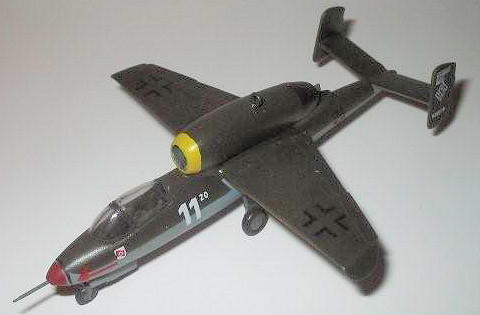 and Junkers
submitted the most promising projects.
Heinkel had already been working on a similar design, so their efforts
were most successful, with the prototype flying for the first time only
sixty-nine days from the official start of design work. The original idea was to
use minimally trained Hitler Youth as pilots, but the flying characteristics
were such that this would have been suicidal, and Luftwaffe planners finally
conceded that experienced pilots would be required.
and Junkers
submitted the most promising projects.
Heinkel had already been working on a similar design, so their efforts
were most successful, with the prototype flying for the first time only
sixty-nine days from the official start of design work. The original idea was to
use minimally trained Hitler Youth as pilots, but the flying characteristics
were such that this would have been suicidal, and Luftwaffe planners finally
conceded that experienced pilots would be required.
The
HE-162 M1, coded VI+IA, w. nr . 200001, first
flew on December, 1944 at Heinkel’s plant at
After a
hurried test program, operational examples were delivered to I/JG 1 at Parchim
begin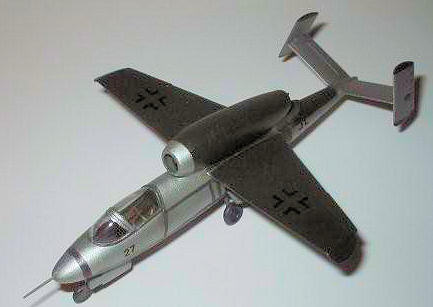 ning in February, 1945.
Training began immediately as new aircraft were delivered, and on
ning in February, 1945.
Training began immediately as new aircraft were delivered, and on
| THE KITS |
I have
built four different kits of the HE-162.
Beginning in the middle sixties, Lindberg produced a series of German
aircraft kits in 1/72 scale, beginning with the ME-163, FW-190D-9, HE-100D, and
HE-162. These were very basic kits,
and the HE-162 kit is probably the best of the lot.
It sold for 39 cents in 1965.
Not too long afterward (again, the Brits never seem to date anything)
Frog issued a slightly better HE-162A.
This was all we had until about 1990 when DML issued a very good kit of
the aircraft, complete with interior detail.
They also issued a Mistel 5 kit which included a pilotless Arado E-377A
jet powered flying bomb. This falls into the Luft 46 category, and I have not
seen this issue. In 2008, the
Chinese Hobby Boss firm produced a simplified kit of the HE-162A, and this is
currently available. It was easy
to build, but all of these kits require weights in the nose for balance. I built
them basically “out of the box” for comparison, as superdetailing would have
negated the purpose of this project.
| CONSTRUCTION |
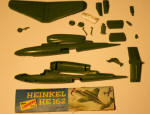 Cast in
bright green plastic, this kit consists of 22 parts, plus a stand and pilot
figure. The one piece wing is extremely thin, and the fuselage halves slide into
place, providing an extremely strong structure. The engine and fuselage are one
unit, and surface detail is raised, including many rivets and panel lines that
should be removed. Aileron and flap
detail is heavy, and
Cast in
bright green plastic, this kit consists of 22 parts, plus a stand and pilot
figure. The one piece wing is extremely thin, and the fuselage halves slide into
place, providing an extremely strong structure. The engine and fuselage are one
unit, and surface detail is raised, including many rivets and panel lines that
should be removed. Aileron and flap
detail is heavy, and
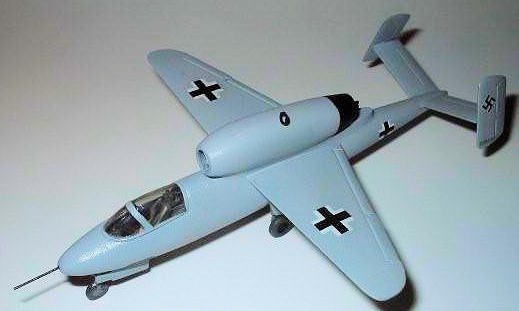 the gun troughs are also in raised relief. Landing gear
detail is weak, and although there is what passes for a seat, there is no
cockpit detail. There is no tail bumper underneath the horizontal stabilizers.
Wheel well detail is absent, and the structural member separating the
landing gear doors is missing. The
canopy is relatively clear, but you can’t see much inside it.
The mainwheels are much too small, and
really should be replaced with some from the spares box.
The outline is reasonably accurate for
its time, but this kit should not be considered by the serious modeler. Since
this kit was probably at least 45 years old when I built it, the decals were
toast.
the gun troughs are also in raised relief. Landing gear
detail is weak, and although there is what passes for a seat, there is no
cockpit detail. There is no tail bumper underneath the horizontal stabilizers.
Wheel well detail is absent, and the structural member separating the
landing gear doors is missing. The
canopy is relatively clear, but you can’t see much inside it.
The mainwheels are much too small, and
really should be replaced with some from the spares box.
The outline is reasonably accurate for
its time, but this kit should not be considered by the serious modeler. Since
this kit was probably at least 45 years old when I built it, the decals were
toast.
I built
one of these previously, about 20 years
ago, so my current model is of the HE-162 M1 prototype, which does not
have the downturned wingtips. From
a distance, it doesn’t look too bad.
Revision of the wingtips was the only modification. The second example is
HE-162A-1, w/nr 300027, discovered by American troops at the Junkers
factory at Bernberg. This model was build about 1991, and shows the aircraft in
unfinished condition (see above).
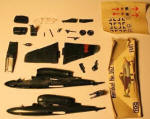 Produced
about the same time as the Lindberg kit, this is not much of an improvement.
The kit features 25 parts cast in dark blue plastic, along with a 2 piece
canopy. The wings have insert
panels in the undersides, calling for some
Produced
about the same time as the Lindberg kit, this is not much of an improvement.
The kit features 25 parts cast in dark blue plastic, along with a 2 piece
canopy. The wings have insert
panels in the undersides, calling for some
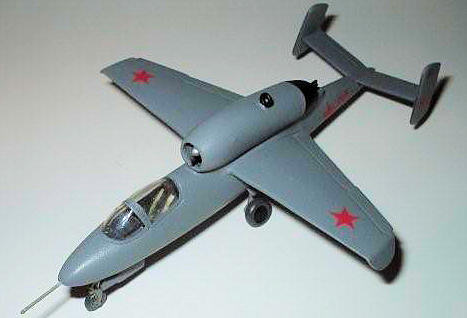 intense filling and sanding. The
rudders fit onto the horizontal stabilizers by means of small tabs, which must
also be filled in. There are some
mold marks on the exterior surfaces that need to be filled in, and there is
almost no interior, except for a large completely useless seat.
There is no front engine compressor spinner, identified as a “starter
motor bullet”, in the engine intake. This is easily scratchbuilt.
The landing gear is very basic, and required some work, especially in the
oleo strut scissors that collect the axles to the gear legs. The nose gear is
much too short, and required an extension in the gear well to get the proper
length. The pitot tube is too
heavy. The gun troughs are accurate, but
the guns are cast in place. These should be removed and drilled out and
replaced. This kit takes a lot of
work and filling to get it to acceptable standards. The decals were totally
disintegrated over time.
intense filling and sanding. The
rudders fit onto the horizontal stabilizers by means of small tabs, which must
also be filled in. There are some
mold marks on the exterior surfaces that need to be filled in, and there is
almost no interior, except for a large completely useless seat.
There is no front engine compressor spinner, identified as a “starter
motor bullet”, in the engine intake. This is easily scratchbuilt.
The landing gear is very basic, and required some work, especially in the
oleo strut scissors that collect the axles to the gear legs. The nose gear is
much too short, and required an extension in the gear well to get the proper
length. The pitot tube is too
heavy. The gun troughs are accurate, but
the guns are cast in place. These should be removed and drilled out and
replaced. This kit takes a lot of
work and filling to get it to acceptable standards. The decals were totally
disintegrated over time.
The DML
Kit
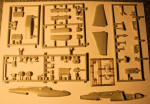 I got
this kit at an auction, so I don’t know what the selling price is. I’ve seen it
listed for $11.00 Australian. The
Dragon Mistel 5 kit lists on EBay for $20.95, but it is described as
discontinued.
I got
this kit at an auction, so I don’t know what the selling price is. I’ve seen it
listed for $11.00 Australian. The
Dragon Mistel 5 kit lists on EBay for $20.95, but it is described as
discontinued.
There was
supposed to be a photo etch sheet with this kit, but it was not included.
The biggest thing was the instrument panel, but I muddled through and
scratch built one.
This kit
has extensive interior details in both the cockpit and the wheel wells. The gun
troughs are well done, but the gun barrels converge too far inwards, so these
should be drilled out and replaced. The pitot tube on the nose is too small, and
should be replaced anyway, as it will never stay on the model during the
assembly process. There are no trim tabs on the rudders.
This is the only model that has the correct shape of the flap trailing
edges at the wing roots. Lindberg
ignores this, and the others only hint at the correct form.
There are some little rings below t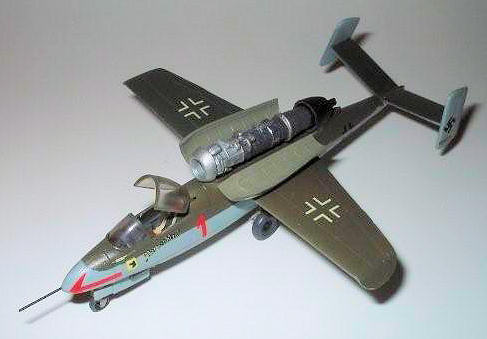 he main wheel axles, and these will
break off if you are not careful.
he main wheel axles, and these will
break off if you are not careful.
This is
the only kit with a detailed engine.
Some photo etch material should have been installed, but it doesn’t look
bad without it. You lose a lot if
you display this model closed up, so leave the cowlings open and raise the
canopy. This is that kind of a kit.
I wouldn’t recommend this kit for beginners, but if you have moderate modeling
skills, you should have no problems with this one.
It is highly labor intensive, and has a lot of very small parts.
I did
this kit as “Red 1”, w/nr 120077, of 2/JG 1 at Leck on 4 may 1945.
Its pilot is unknown. This
aircraft was captured at Leck, and
was shipped to the U.S. for evaluation after being examined by Col.
Watson’s “Whizzers”. It was
flown only once, by Bob Hoover.
Eventually, the plane was acquired by Ed Maloney, who restored it and exhibited
it in his Planes of fame Museum at Chino Airport, California.
It is still there.
 There are
23 parts to this kit, with very simplified construction. The kit probably
represents the HE-162A-2, but this is not indicated on the four page color
instruction sheet. Instructions are
clear, and the painting guide is useful, with RLM colors being indicated.
Almost no documentation is provided for these color schemes, although I
have seen photos of both aircraft depicted. Decals are provided for the Soviet
example and for “White 4”, an aircraft
of I/JG 1 at Leck, in May, 1945.
There are
23 parts to this kit, with very simplified construction. The kit probably
represents the HE-162A-2, but this is not indicated on the four page color
instruction sheet. Instructions are
clear, and the painting guide is useful, with RLM colors being indicated.
Almost no documentation is provided for these color schemes, although I
have seen photos of both aircraft depicted. Decals are provided for the Soviet
example and for “White 4”, an aircraft
of I/JG 1 at Leck, in May, 1945.
It should
be noted that I bought one of these kits last year when they were first issued,
and a molding defect in the rear fuselage resulted in returning the kit to the
store. The one I bought a couple of
weeks ago was OK. Check this,
although I don’t know whether this was an isolated example or a feature of the
first production batch. In any event, it was poor quality control.
The whole rear fuselage needed a shot of Viagra.
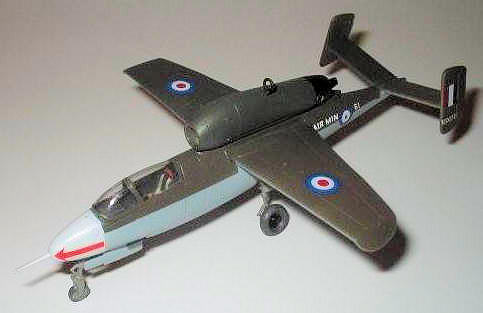 There are
a few outline and detail discrepancies, including the outline of the flap and
ailerons. The model needs to be
weighted for balance, but there isn’t much room for this, although a little bit
of shot in the forward fuselage did the trick. Rudder trim tabs are overdone,
but these are easily trimmed off. The cannon troughs are correct in outline, but
the guns aim inward at a grotesque angle. They need to be removed and replaced.
There is little cockpit detail, as is typical with Hobby Boss kits, but the seat
and control stick don’t look too bad through the glass.
A paper or decal instrument panel will help, and the tiny Revi gunsight
is visible. Just don’t lose it, as
it is very small. The wheels, incidentally, are identical to those of the DML
kit, and other parts are very close.
This might be a simplified version of the DML kit.
There are
a few outline and detail discrepancies, including the outline of the flap and
ailerons. The model needs to be
weighted for balance, but there isn’t much room for this, although a little bit
of shot in the forward fuselage did the trick. Rudder trim tabs are overdone,
but these are easily trimmed off. The cannon troughs are correct in outline, but
the guns aim inward at a grotesque angle. They need to be removed and replaced.
There is little cockpit detail, as is typical with Hobby Boss kits, but the seat
and control stick don’t look too bad through the glass.
A paper or decal instrument panel will help, and the tiny Revi gunsight
is visible. Just don’t lose it, as
it is very small. The wheels, incidentally, are identical to those of the DML
kit, and other parts are very close.
This might be a simplified version of the DML kit.
| CONCLUSIONS |
The early
HE-162 kits are pretty crude by modern standards, but they were state-of-the-art
when they first appeared. All of
the kits require some work, and you’ll use some filler regardless of the kit you
build. They are all pretty accurate in outline if lacking in detail (DML kit
excepted), and with some work, all of them can be made into a decent model if
you don’t mind the work.
It is obvious that the DML kit is probably the best of the lot, both in detail and accuracy. If you are really desperate, try the Hobby Boss kit, as it is cheap and readily available. Whatever kit you choose, be sure to have some reference material handy, as the kit instructions are sometimes incomplete or confusing. It is good to know that this very interesting Luftwaffe fighter can be modeled in 1/72 scale rather easily, and it fills a big gap in any 1/72 model collection of World War II fighters.
| REFERENCES |
Reference material on the Heinkel HE-162A is readily available. The first 1/72 scale drawings of the aircraft appeared just postwar in the British Harleyford series, AIRCRAFT OF THE FIGHTING POWERS, but these were somewhat inaccurate. In the early sixties, Profile No. 203 presented a history of the type, along with color views and much data, but the issue has no publication date, a common problem with this type of British publication. Numerous short articles have been published in various books and periodicals over the years. Royal Navy Capt. Eric Brown’s WINGS OF THE LUFTWAFFE, published in 1987, presents excellent cutaway drawings of the type, along with a firsthand pilot’s reports, as he flight tested nearly all of the German aircraft that fell into British hands. In 1986, Monogram Publications produced a Close-Up on the aircraft, which is an excellent reference, including many photos and color drawings. The Schiffer Military History Series book on the HE-162A by David Myhra also presents some interesting material, but this is more of a photographic record than a direct history of the type, and the main text consists of captions. In addition, a lot of photos of models depicting the development projects are included. Another interesting source is Phil Butler’s book WAR PRIZES, a fascinating work which details the histories of all of the German, Japanese, and Italian aircraft captured by the Allies during World War II. This book is worth getting if you can find one. There is certainly no shortage of information on the HE-162.
If you would like your product reviewed fairly and quickly, please contact the editor or see other details in the Note to Contributors.